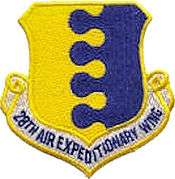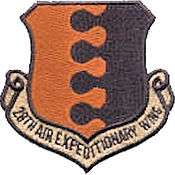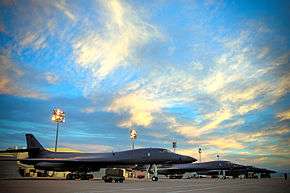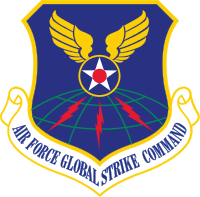28th Bomb Wing
| 28th Bomb Wing | |
|---|---|
|
B-1B Lancers of the 28th Bomb Wing on the flight line at Ellsworth AFB | |
| Active | 1947-1948, 1948-Present |
| Country |
|
| Branch |
|
| Role | bombardment |
| Part of |
Global Strike Command 8th Air Force |
| Garrison/HQ | Ellsworth Air Force Base, South Dakota |
| Motto(s) | Guardian Of The North |
| Aircraft | B-1B Lancer |
| Decorations | see "Lineage and Honors" section below |
| Commanders | |
| Current commander | Colonel Gentry Boswell |
| Notable commanders |
Brigadier General Richard E. Ellsworth Brigadier General Clinton H. Winne Jr. Brigadier General Joseph C. Wilson Jr. Lieutenant General Robert C. Hinson |
| Insignia | |
| 28th Bomb Wing emblem (approved )[1] |
 |
The 28th Bomb Wing (28 BW) is a United States Air Force unit assigned to the Eighth Air Force (8 AF) of the Global Strike Command (GSC) and is stationed at Ellsworth Air Force Base, South Dakota. The wing is also the "host unit" at Ellsworth AFB.
The wing is one of only two B-1B Lancer strategic bomber wings in the United States Air Force, the other being the 7th Bomb Wing at Dyess Air Force Base, Texas.
Active for over 60 years, the 28 BW was a component wing of Strategic Air Command's deterrent force throughout the Cold War.
The 28th Bomb Wing is commanded by Colonel Gentry Boswell since 2015;[2] its Command Chief Master Sergeant is CMSgt Sonia Lee.[3]
Units
- 28th Operations Support Squadron
- 34th Bomb Squadron
- 37th Bomb Squadron
- 28th Mission Support Group
- 28th Civil Engineering Squadron
- 28th Communications Squadron
- 28th Contracting Squadron
- 28th Logistics Readiness Squadron
- 28th Force Support Squadron
- 28th Security Forces Squadron
- 28th Maintenance Group
- 28th Aircraft Maintenance Squadron
- 28th Maintenance Squadron
- 28th Munitions Squadron
- 28th Maintenance Operations Squadron
- 28th Medical Group
- 28th Medical Operations Squadron
- 28th Medical Support Squadron
Background of name
The motto "Guardian of the North" hails from the 28th Operations Group's World War II service in Alaska, the Aleutian Islands, and the Kuril Islands. The 28th Bomb Wing carries on the traditions of the 28th Operations Group.
Myth: The motto "Guardian of the North" is not related in any way to the wing's Cold War service with B-52 Stratofortress bombers. Although this motto seems to dovetail nicely with the idea of guarding the north (whether spearheading an attack over the North Pole, or defending against one) from the Soviets, this is definitely not the case.
History
- For additional history and lineage, see 28th Operations Group
The 28th Bomb Wing, under various designations, has been assigned to Ellsworth Air Force Base, South Dakota for over 60 years. It is the longest assigned active-duty unit at a single base in the United States Air Force.
Cold War


Established as the 28th Bombardment Wing, Very Heavy on 28 July 1947. Maintained proficiency in heavy bombardment, 1947–1948. Maintained proficiency in global bombardment, deploying tactical components or segments thereof as needed, 1948–1950.
In March 1953 an RB-36 and its entire crew of 23 crashed in Newfoundland while returning from a routine exercise in Europe. On 13 June 1953, President Dwight D. Eisenhower made a personal visit to dedicate the base in memory of Brig Gen Richard E. Ellsworth, commander of the 28th Strategic Reconnaissance Wing, who lost his life in that accident.
Although the wing's aerial reconnaissance capability lasted until September 1958, by April 1955 the Air Force had already changed the wing back to its former status as the 28th Bombardment Wing, Heavy, under the 15th Air Force (later attached to the 3rd Air Division), which specialized almost exclusively in ordnance delivery. Headquarters Strategic Air Command (SAC) reassigned the 28 BMW from 8th Air Force back to 15th Air Force in October 1955.
Deployed at Andersen Air Force Base, Guam, April–July 1955.
Approximately one year later, SAC set plans in motion to replace the 28th's B-36s with the new all-jet B-52 Stratofortress. The last B-36 left Ellsworth on 29 May 1957 and the first B-52 arrived sixteen days later. In 1958 all base units came under the command of the 821st Strategic Aerospace Division, headquartered at Ellsworth. On 26 September 1958, two 28th wing B-52Ds set world speed records. One flew a 5,000 km closed course at an average speed of 597.695 mph, while the other flew a 10,000 km closed course at a speed of 560.705 mph.[4]:259
Added aerial refueling to mission in 1959 and began operating post-attack command and control system for Fifteenth Air Force in January 1965, maintaining this capability through a rear echelon during the absences of the remainder of the wing.
Controlled a non-equipped Titan missile squadron, December 1960 – December 1961.
B-52Ds assigned to the wing set
In April 1966, B-52Ds of the wing, together with D series bombers of the 484th Bombardment Wing deployed to Andersen Air Force Base, Guam, replacing the B-52Fs that SAC had been deploying to Andersen for the Vietnam War since the previous year. The 29th's planes and other B-52Ds had been modified under a program called Big Belly, which increased the bombload of wing aircraft to 84 500 lb bombs or 42 750 lb bombs, from the 27 it could previously carry.[4]:256 From this point, the Big Belly B-52D became the SAC workhorse in Southeast Asia.
Except for a small rear echelon left at Ellsworth, the wing's headquarters staff, tactical aircraft and crews, and most support personnel were integrated into Arc Light forces for combat in Southeast Asia, c. 9 March – c. 21 September 1966, c. 15 January – c. 19 July 1968, and c. 9 September 1969 – c. 18 March 1970. From April 1972 to October 1973 the wing also had most of its tactical aircraft and crews on loan to SAC organizations involved in combat operations, and the wing continued supporting Pacific forces with planes and crews into 1975.
Converted from B-52G to B-52H models in 1977. Performed airborne launch control functions for USAF Minuteman missile wings with EC-135 aircraft and provided logistic support to the 44th Missile Wing. Expanded B-52H mission in 1984 to include sea reconnaissance, surveillance, and conventional operations from forward bases overseas. Upgraded tanker force to KC-135R in 1985–1986.
In 1986 the 28 BMW made extensive preparations to phase out the aging B-52 fleet and become the new home for the advanced B-1 Lancer. Contractors completed new unaccompanied enlisted dormitories in March, a new security police group headquarters in October, and gave Ellsworth's 13,497 foot runway a much-needed facelift. In addition, they completed new aircraft maintenance facilities for the complex new B-1B. In January 1987, the wing received the first of 35 B-1B bombers.
The 37 BS returned to operational duty with the 28 BW in January 1987, just in time to join the 77 BS in training on the new bombers. The first B-1B arrived on 21 January 1987. In July 1988 the 57th Air Division became the wing's new higher headquarters. In 1989 the wing's B-1Bs earned the Fairchild Trophy, Crumm Linebacker Trophy, Eaker Trophy, and the Omaha Trophy for superior bomber operations and the most outstanding wing in SAC. The wing also provided tanker support for Operation Just Cause, December 1989 – January 1990.
In July 1990 the Strategic Warfare Center became the latest of the wing's intermediate headquarters. Adding to its extensive combat experience, the wing deployed both tanker and airborne command post aircraft to Operation's Desert Shield/Desert Stormfrom August 1990 – March 1991.
On 1 September 1991 SAC redesignated the 28 BW as the 28th Wing, and once again assigned it directly under Eighth Air Force, and as part of the new objective wing organization, reactivated the old 28 BG under the new name of the 28th Operations Group. The 28th Wing also regained host wing responsibilities for Ellsworth AFB from the 44th Missile Wing.
Post Cold War era


With the end of the Cold War, on 28 September 1991 the Secretary of Defense ordered B-1Bs and tankers off alert. The 4 ACCS continued to maintain an alert crew until May 1992. On 1 June 1992, simultaneously, SAC inactivated, Air Combat Command activated, the 28th Wing changed names to the 28th Bomb Wing, and the 28 AREFS became a geographically separated unit assigned to Malmstrom Air Force Base, Montana. In September 1992 the 4 ACCS also inactivated, having effectively worked themselves out of a job by providing airborne command and control so faithfully for so long.
In 1993 the wing's B-1Bs were the first in ACC to transition from their former strategic role to an all-conventional mission. The 28th's operational squadrons could conceivably touch anywhere in the world to meet national defense needs. Ellsworth tested this concept in 1993 and early 1994 during such events as: "Team Spirit" (the first B-1Bs ever to land in South Korea); "Global Power" (various long-duration, round trip sorties flown from Ellsworth to bomb training ranges in another continent.); and "Bright Star" (the wing's second but the B-1Bs first visit to a major JCS exercise in Southwest Asia).
From June through December 1994, 28 BW B-1Bs participated in a Congressionally directed operational readiness assessment known locally as "Dakota Challenge." Towards the end of the exercise the wing deployed a squadron to Roswell, NM, to simulate flying from an austere location at wartime sortie rates. This test proved the B-1B to be a versatile weapon system. Excellent results were obtained. However, World Airpower Journal argued that '[i]t could be argued that the excellent results were meaningless, because they were so unrepresentative. Spare parts, equipment and people were brought in from the 7th BW and the 384th BW, at last bringing up the 28th up to 100% in all three respects. This was done at the expense of degrading the other two wings. It did however show what was possible, given funding and commitment.'.[5] The journal favorably quoted General John M. Loh in this regard.
On 31 March 1995, the 77 BS—a unit that had served under the wing since 1948—inactivated. Its B-1Bs became part of ACC's reconstitution reserve. This action freed funds to allow the Air Force to develop new precision-guided munitions. The Air Force announced in early 1996 that the 77 BS would once again activate under the 28 BW on 1 April 1997. In November 1998, they received the first Block D upgraded B-1B in the USAF inventory. The Block D upgrade brings the capability for the B-1 to drop the Joint Direct Attack Munition (JDAM), which is a global positioning system (GPS) guided munition. (These are the upgrades that were paid for with the funds that were freed during the 77 BS's inactivation).
One B-1B from the 28th Bomb Wing departed for Southwest Asia 18 December 1997 to supply additional bomber forces in the Middle East. The 7th Bomb Wing at Dyess Air Force Base also launched a B-1B 18 December. This brings the total number of B-1Bs in theater to six—three from Ellsworth and three from Dyess. B-1Bs from both bases saw their first combat action in air raids over Iraq 17 December 1997. Details on the number of B-1Bs used and battle damage assessment information has not been released; however, the missions were characterized as "very successful."
In December 1998, 28 BW deployed aircraft, which flew under the flag of the 28th Air Expeditionary Group in Operation Desert Fox, were the first B-1s to drop bombs on an enemy target.
In late March 2011, B-1 bombers from the 28th Bomb Wing were deployed on a mission to Libya to attack military targets in support of Operation Odyssey Dawn.[6]
The Department of the Air Force announced in the spring of 2015 that effective 1 October 2015 the 28th, along with the 7th Bomb Wing at Dyess Air Force Base would be realigned under Air Force Global Strike Command, reuniting all the Air Force's bomber and strategic missiles under a single command for the first time since Strategic Air Command was discontinued 23 years earlier.[7][8]
Operations and Decorations
- Combat Operations: Except for a small rear echelon left at Ellsworth AFB, SD, the wing's headquarters staff, tactical aircraft and crews, and most support personnel were integrated into ARC LIGHT forces for combat in Southeast Asia, c. 9 March-c. 21 September 1966, c. 15 January-c. 19 July 1968, and c. 9 September 1969-c. 18 March 1970. From Apr 1972 to Oct 1973 the wing also had most of its tactical aircraft and crews on loan to SAC organizations involved in combat operations, and the wing continued supporting Pacific forces with planes and crews into 1975. In Nov 1997, deployed four B-1s and crews to Southwest Asia for a show of force against Iraq, the first real-world contingency use of the B-1 bomber. A year later (Nov 1998), the wing deployed three B-1s and crews to Southwest Asia for punitive attacks against Iraqi targets, the first combat use of the B-1. After terrorist attacks against the United States in Sep 2001, the wing deployed B-1 aircraft and crews to Diego Garcia, an island in the Indian Ocean, for bombing missions against enemy targets in Afghanistan.
- Campaigns: None
- Decorations: Air Force Outstanding Unit Awards with Combat "V" Device: 1 June 2001 – 31 May 2003; 20 September 2001 – 17 January 2002 (conferred). Air Force Outstanding Unit Awards: 1 September 1957 – 30 June 1958; 1 January-31 Dec 1966; 1 January-1 Mar 1968; 2 March-1 Jul 1968; 9 June-10 Jul 1972; 1 July 1976 – 30 June 1978; 1 July 1978 – 30 June 1980; 1 July 1981 – 30 June 1983; 1 July 1988 – 30 June 1990; 1 June-30 Nov 1994; 1 June 1997 – 31 May 1999; 1 June 2003 – 31 May 2005.
In 1989, won the Fairchild Trophy for excellence in bombing and navigation and the Omaha Trophy, presented to the outstanding wing in SAC.
Lineage
- Designated as the 28th Bombardment Wing, Very Heavy on 28 July 1947
- Organized on 15 August 1947
- Redesignated 28th Bombardment Wing, Medium on 12 July 1948
- Redesignated 28th Bombardment Wing, Heavy on 16 May 1949
- Redesignated 28th Strategic Reconnaissance Wing on 1 April 1950
- Redesignated 28th Strategic Reconnaissance Wing, Heavy on 16 July 1950
- Redesignated 28th Bombardment Wing, Heavy on 1 October 1955
- Redesignated 28th Wing on 1 September 1991
- Redesignated 28th Bomb Wing on 1 June 1992.
- Wing resources form the provisional 28th Air Expeditionary Wing when the wing is the primary force provider for deployments.
Assignments
|
|
Components
- Groups
- 28th Bombardment (later, 28th Strategic Reconnaissance; 28th Operations) Group: 15 August 1947 – 16 June 1952; since 1 September 1991
- Detached 19 July – 18 October 1948
- Squadrons
- 4th Airborne Command and Control: 1 April 1970 – 1 September 1991
- 37th Bomb Squadron: 1 July 1977 – 1 October 1982; 1 January 1987 – 1 September 1991
- 77th Strategic Reconnaissance (later, 77th Bombardment) Squadron: attached 10 February 1951 – 15 June 1952, assigned 16 June 1952 – 1 September 1991 (detached c. 9 March-c. 21 September 1966, c. 15 January-c. 19 July 1968, c. 19 August 1969-c. 23 March 1970).
- 717th Strategic Reconnaissance (later, 717th Bombardment) Squadron: attached 10 February 1951 – 15 June 1952, assigned 16 June 1952 – 1 February 1960
- 718th Strategic Reconnaissance (later, 718th Bombardment) Squadron: attached 10 February 1951 – 15 June 1952, assigned 16 June 1952 – 20 February 1960
- 928th Air Refueling Squadron: 1 February 1959 – 1 October 1960
- Redesignated: 28th Air Refueling Squadron: 1 October 1960 – 1 September 1991 (detached c. 9 March-c. 21 September 1966, c. 15 January-c. 19 July 1968, c. 19 August 1969-c. 23 March 1970)
- 97th Air Refueling Squadron: 1 July 1962 – 15 March 1964
- 850th Strategic Missile Squadron: 1 December 1960 – 1 January 1962
Stations
- Rapid City Army Air Field (later Rapid City Air Force Base; Ellsworth Air Force Base), South Dakota, since 3 May 1947
- 28th BG deployed at RAF Scampton, England, 19 July – 19 October 1948
- 77th BS deployed to Andersen Air Force Base, Guam, c. 9 March – c. 21 September 1966, c. 15 January – c. 19 July 1968, and c. 9 September 1969 – c. 18 March 1970
Aircraft assigned
|
|
References for commands and major units assigned, components and stations:[9][10][11]
See also
References
Notes
- ↑ Robertson, Patsy (20 November 2009). "Factsheet 28 Bomb Wing (ACC)". Air Force Historical Research Agency. Archived from the original on 4 March 2016. Retrieved June 26, 2014.
- ↑ "Colonel Gentry Boswell". US AirForce. June 2015. Archived from the original on 18 September 2016. Retrieved 12 June 2015.
- ↑ "CMSgt Sonia Lee". US AirForce. August 2015. Archived from the original on 18 September 2016. Retrieved 2 September 2015.
- 1 2 Knaack, Marcelle Size (1988). Encyclopedia of US Air Force Aircraft and Missile Systems. Vol. 2, Post-World War II Bombers 1945-1973. Washington, DC: Office of Air Force History. ISBN 0-912799-59-5.
- ↑ World Air Power Journal, Vol 24, Spring 1996, p.101
- ↑ "Bombers from Ellsworth AFB part of Libya strikes". Argus Leader. 30 March 2011. Archived from the original on 22 April 2011. Retrieved 23 April 2011.
- ↑ "AF realigns B-1, LRS-B under Air Force Global Strike Command". Secretary of the Air Force Public Affairs. Retrieved May 6, 2015.
- ↑ "28th Bomb Wing to join Air Force Global Strike Command". 28th Bomb Wing Public Affairs. 20 April 2015. Archived from the original on 4 March 2016. Retrieved 18 September 2016.
- ↑ Ravenstein, Charles A. (1984). Air Force Combat Wings Lineage and Honors Histories 1947–1977. Maxwell AFB, Alabama: Office of Air Force History. ISBN 0-912799-12-9
- ↑ Maurer, Maurer, ed. (1983) [1961]. Air Force Combat Units of World War II (PDF) (reprint ed.). Washington, DC: Office of Air Force History. ISBN 0-912799-02-1. LCCN 61060979.
- ↑ Rogers, Brian. (2005). United States Air Force Unit Designations Since 1978. Hinkley, UK: Midland Publications. ISBN 1-85780-197-0.
Bibliography
![]() This article incorporates public domain material from the Air Force Historical Research Agency website http://www.afhra.af.mil/.
This article incorporates public domain material from the Air Force Historical Research Agency website http://www.afhra.af.mil/.
- Ravenstein, Charles A. (1984). Air Force Combat Wings, Lineage & Honors Histories 1947-1977 (PDF). Washington, DC: Office of Air Force History. ISBN 0-912799-12-9.




